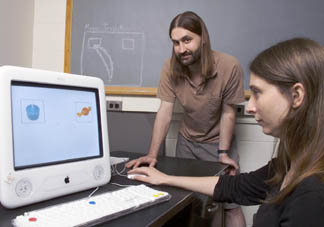News flash: Mental Processing Is Continuous, Not Like a Computer
 Michael Spivey (pictured) and his collaborators at Cornell did a cute little study, where they tracked the movement of the subject’s mouse as they tried to move it toward a picture on the computer screen corresponding to the word they had just heard. When the two pictures were of items whose lexical representations are “close” (think “candy” vs. “candle”) the mouse darted tentatively toward one before converging on the correct one. As the authors say in the abstract, “competition between partially active lexical representations are revealed in the shape of the movement trajectories”.
Michael Spivey (pictured) and his collaborators at Cornell did a cute little study, where they tracked the movement of the subject’s mouse as they tried to move it toward a picture on the computer screen corresponding to the word they had just heard. When the two pictures were of items whose lexical representations are “close” (think “candy” vs. “candle”) the mouse darted tentatively toward one before converging on the correct one. As the authors say in the abstract, “competition between partially active lexical representations are revealed in the shape of the movement trajectories”.
This seems like a useful thing to do, while hardly qualifying as a breakthrough.
But does Spivey really believe the stuff they quote him as saying in the brain-damaged press release put out by Cornell? He supposedly said
For decades, the cognitive and neural sciences have treated mental processes as though they involved passing discrete packets of information in a strictly feed-forward fashion from one cognitive module to the next or in a string of individuated binary symbols—like a digital computer.”
No they didn’t. That was one, discredited, easily refuted model. He goes on:
In [our new] model, perception and cognition are mathematically described as a continuous trajectory through a high-dimensional mental space; the neural activation patterns flow back and forth to produce nonlinear, self-organized, emergent properties—like a biological organism.
Well, gee whiz. Maybe that’s because it is.
PS. It does not seem altogether irrelevant that Spivey is apparently the inventor of the Spivey Test, where instead of computers trying to act like humans, humans try to act like computers.
